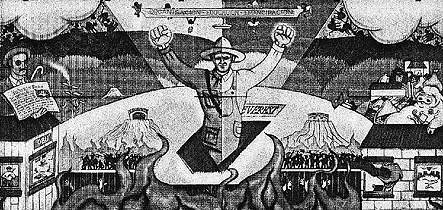
On Saturday, December 13, artist Mike Alewitz dedicated his mural of labor martyr Wesley Everest in Centralia, Washington. It was a cold day, as was the day in 1919 which the mural commemorates, the day the courageous Everest was captured by a lynch-mob and hanged over the Skookumchuck river. That day the river had ice at its edges.
The mural depicts Everest rising from his grave, surrounded by many references to the Industrial Workers of the World (the IWW, Everest's union), and to the history of the region. The mural dedication began with a flag ceremony by local scouts. One speaker was Esther Barnett Goffin of Idaho, the daughter of Eugene Barnett, one of the unionists convicted of murder, although he was clearly innocent. Relatives of Wesley Everest and local labor leaders also spoke. Alewitz dedicated his mural to two political prisoners. The first, Mumia Abu-Jamal, is a journalist who many believe was framed by the Philadelphia police for a murder he did not commit. He has been languishing for years on death row in Pennsylvania. The second, Roisin McAliskey, is an Irish human-rights fighter.
There was controversy about the painting of the mural. The American Legion attempted to prevent it from being painted. They hold that IWW members murdered five local Legionnaires in 1919 and should thus not be commemorated. There is a large old brass statue comemorating the Legionnaires who were killed, standing in the center of the square which the mural faces.
During the Armistice Day parade on November 11, 1919, the American Legion Post 17 in Centralia, Washington, attacked the union hall of the IWW. The Wobblies, as IWW members are known, were warned of the attack in advance. The Wobblies were further prepared because this was not an isolated incident. Their hall had already once been damaged by a Legionnaire attack. There was pressure nationally, both from within the American Legion and from the ruling class of the country, to eliminate labor organizing. Under cover of the war hysteria, the ruling class was using illegal and unconstitutional methods to prevent what they feared would be a socialist revolution.

Five Legionnaires were killed while storming the IWW hall. In revenge, other Legionnaires went door-to-door to hunt for Wobblies and Wobbly sympathizers. Dragnet operations by lynch-mobs combed the nearby forests, beating and dragging people to jail. Because of the confusion in differentiating Legionnaires from union members, a member of one lynch-mob was shot by "friendly fire" of another. (For a detailed history, read the book Wobbly War: The Centralia Story, by John McClelland Jr, published by the Washington State Historical Society.)
The prison was full of IWW members, who were constantly threatened and tortured by the Legionnaires. One night, there was a short electrical blackout, which had been planned to allow several people to tie up Wesley and take him out to be tortured, castrated by the local doctor, and hung by his neck from the bridge.
Wesley's efforts as a member of the IWW and a veteran of the world war, to improve working conditions for returning veterans and other workers, were ended by his brutal murder, and eight other Wobblies spent ten to fifteen years each in prison on murder charges for the deaths of the five Legionnaires who attacked their hall. One prisoner, Loren Roberts, was driven insane by the torture of the Legionnaires. No one was ever charged with the murder of Wesley Everest. All of these lives will have been wasted if the Wobbly War is not publicly discussed. Centralia residents have for nearly 80 years felt largely unable to do so, until now.
The Legionnaires' role as individuals is not always clear in this history. At the mural dedication, the daughter of Ben Casagranda, one of the slain Legionnaires, told the crowd that her father had delayed leaving his home that day, and only reluctantly participated in the parade because, as he told his wife, he didn't like what they were up to. Another example is that the current commander of the Legion is a relative of the wife of Wesley Everest. However, Vivian Jacobs, past commander of the post, called for a boycott of the businesses in the building upon which the mural is painted.
Near downtown Centralia is an area called "Little Tijuana". This is where the laborers of the area today live in conditions similar to those the Wobblies were fighting to improve. Several people at the dedication mentioned that the Mexican lumber workers, inhabitants of "Little Tijuana," were fearing retribution if they attended the dedication ceremony.
Opposition to the mural in part has to do with preventing the example of the IWW union from inspiring this generation of workers. The timber industry still fears union organizing.
A long-time resident I spoke with the day of the dedication shared with me his belief that the nearly idyllic Centralia had failed to flourish largely because of the suppression of the history of the attack on the Wobblies. The attack was planned by some of Centralia's prominent people. It is ironic that the mural is painted on the building containing the old Elk hall, since the Elks were involved with the planning of the attack.
The tragic ending to the attack on the union hall was most likely unexpected, and the tragedy of the incident was compounded with the attempt to cover up and hide the details. Assuming the guilty and their families have a conscience, they too have suffered from attempts to hide the truth. Most people in Centralia know more or less what happened during the Wobbly Massacre, including the name of the doctor who castrated Wesley, and the people who lynched him. By providing opportunities for open communication and further discussion, the mural could potentially bring peace among people and maybe the beginning of more prosperous times for the working people of Centralia, although the main motivation of the year-long project was to symbolize the revitalization of the labor movement today.
 |
 |
 |
 |
 |